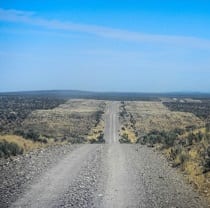Fuels & Fuel Treatments
View article.
Strategic development and implementation of burn boss training may increase the likelihood that burn bosses can safely and effectively implement prescribed burns. This article presents a case study for applying key adult learning methods to improve training effectiveness that can be applied to other training topics in and outside wildland fire management.
Webinar recording.
The California Canyon Fire Experiment is the first large-scale field experiment that observed fire eruption. The experiment was conducted in a steep canyon near Salinas, CA on 24 October 2022. A large suite of in situ and remote sensing instruments were deployed including micrometeorological towers, Doppler radar and lidar and airborne infrared imaging systems. The experiment was designed to allow a head fire to spread freely up a canyon under weak ambient winds to investigate the mechanisms of fire eruption. Preliminary results indicate that fire eruption occurred after the fire front reached the upper region of the canyon and fire spread was dominated by fire-induced in-drafts measured by Doppler lidar. This presentation will describe the goals of the experiment, experimental design, the phenomena sampled, the instruments used, and preliminary results.
View article.
Abundances of dominant invaders, cheatgrass and Russian thistle, were measured along treated and neighboring untreated edges in 40 paired plots along ∼61 km of 60-m wide fuel breaks. Fuel breaks were constructed using a variety of shrub-cutting and herbicide applications 1–4 yr before measurement. Generalized linear mixed effect models revealed that fractional cover significantly increased in treated compared with untreated areas by 0.02–0.12 for cheatgrass and 0–0.06 for Russian thistle within 9 m of treatment boundaries (on a scale of 0-1). We neither detected increased invasion in adjacent and untreated areas nor gradients of increasing invasion with proximity to treatment boundaries. Although these findings reveal invasions that were otherwise undetected across the entire 60 m width of fuel breaks, invasion levels did not surpass nominal management thresholds for fire behavior or risk of conversion to annual grasslands.
View brief.
An extreme multi-year drought with extensive bark beetle outbreaks in California from 2012 to 2016 killed an estimated 147 million trees. This included ponderosa pine, incense cedar, white fir, and pinyon pine, rapidly changing forests over vast areas. Recently published work by Rocky Mountain Research Station (RMRS) researchers Sharon Hood and Charlotte Reed found that major tree mortality events like these increase surface and canopy fuels— dead needles, branches, and logs— which may result in more extreme forest fires and increased emissions when these areas burn. “Hopefully, this research heightens awareness about how quickly our forests can change under extreme mortality events and the potential long-lasting hazards that are created,” says Hood.
View article.
Increasing impacts from wildfires are reshaping fire policies worldwide, with expanded investments in a wide range of fuel reduction strategies. In many fire prone regions, especially in the Mediterranean basin, fuel management programs have relied on fuel break networks for decades to facilitate fire suppression and reduce area burned and damage. By contrast, on the fire prone federal forests in the western United States, fuel management is guided primarily by landscape restoration goals, including improving fire resiliency such that wildfires can be managed for ecological benefit, and suppression is used more as a tool to shape burn patterns and less to extinguish fires. New policies in both fire systems are now calling for hybrid approaches that rely on both types of investments and efficient allocation of alternative spatial treatment patterns: linear networks versus patches across the landscape. However, studies that combine these strategies and examine alternative co-prioritization outcomes and potential synergies are largely non-existent. Here, we analyzed scenarios for implementing both types of treatments in concert while varying the prioritization metrics for one type or the other on a western United States national forest.
View article.
We evaluated the responses of forest structure, regeneration, old-tree mortality, and tree growth to forest restoration for 21 years in a landscape-scale (2114 ha) experiment in a ponderosa pine-Gambel oak forest in northern Arizona, United States. Relative to the start of the experiment in 1996, tree density and basal area (BA) in the treated area were reduced by 56 and 38%, respectively, at the end of the study period compared to the untreated control. Conifer seedling densities generally declined and sprouting hardwoods increased following treatment. Mortality of old oak trees was significantly higher in the treated area compared to the control, likely due to fire-caused injury during the prescribed burning. Mean annual BA increment of individual trees was 93% higher in the treated area than in the control. Our study provides new information on ponderosa pine forest responses to restoration treatments at broad spatial scales and under realistic operational conditions. Results from this study can help inform landscape-scale restoration projects in dry, fire-dependent forests.
View article.
To evaluate forest restoration and fuel treatment benefits and costs, we conducted a meta-analysis of benefit-cost ratios for restoration benefit types documented in the literature for Western U.S. dry mixed conifer forests at risk of uncharacteristic wildfires. A total of 120 observations were collated from 16 studies conducted over the last two decades, with benefits ranging from enhanced ecosystem services to extensively avoided wildfire costs. Significant variation in the value of restoration and fuel treatment benefit types was found, indicating that restoration benefits differ in value based on societal importance. Overall, 17 individual benefit types were aggregated to show that in the most valuable and at-risk watersheds, every dollar invested in forest restoration can provide up to seven dollars of return in the form of benefits and provide a return-on-investment of 600%.
View article.
Our pinyon jay abundance model allowed abundance relationships with pinyon pine and juniper to vary by ecoregion, thereby accounting for potential regional differences in habitat associations. We found pinyon jay abundance was generally positively associated with pinyon pine and juniper cover; however, habitat relationships varied by ecoregion. Additionally, we found positive associations between jay abundance and grass cover, sagebrush cover, and percent bare ground. Our results agree with prior research suggesting mechanical removal of pinyon pine and juniper trees for sagebrush restoration or fuel treatments may negatively affect pinyon jay. Managers wishing to reduce pinyon and juniper tree cover without negatively affecting pinyon jay may benefit from targeting sites where both large-scale distribution models and our local habitat relationships suggest pinyon jay are likely to occur in low numbers. Additionally, our modeled relationships indicate restoration that increases grass cover, sagebrush cover, and bare ground, while maintaining pinyon and (or) juniper cover, may lead to increased local densities of pinyon jay.
View factsheet.
Forest management offers a diverse toolkit for delivering carbon benefits, with biochar fitting in as a cornerstone in combination with other climate-smart practices. For example, selective thinning can help promote healthier stands that capture more carbon while reducing fire risk. In turn, this generates more merchantable timber, which when used
sustainably, can also serve as a long-term carbon store, further offsetting emissions. Additionally, forests can be strategically managed to promote reforestation and afforestation efforts, expanding overall carbon sequestration potential.
View factsheet.
Mechanical thinning of forests is one method used to prevent high intensity wildfire and create a more open overstory. This Science You Can Use outlines how this treatment benefits native understory plants like grasses and sedges. Forests that were treated had higher understory species diversity, and native understory plants were more abundant. This research helps to inform restoration and forest management practices.





